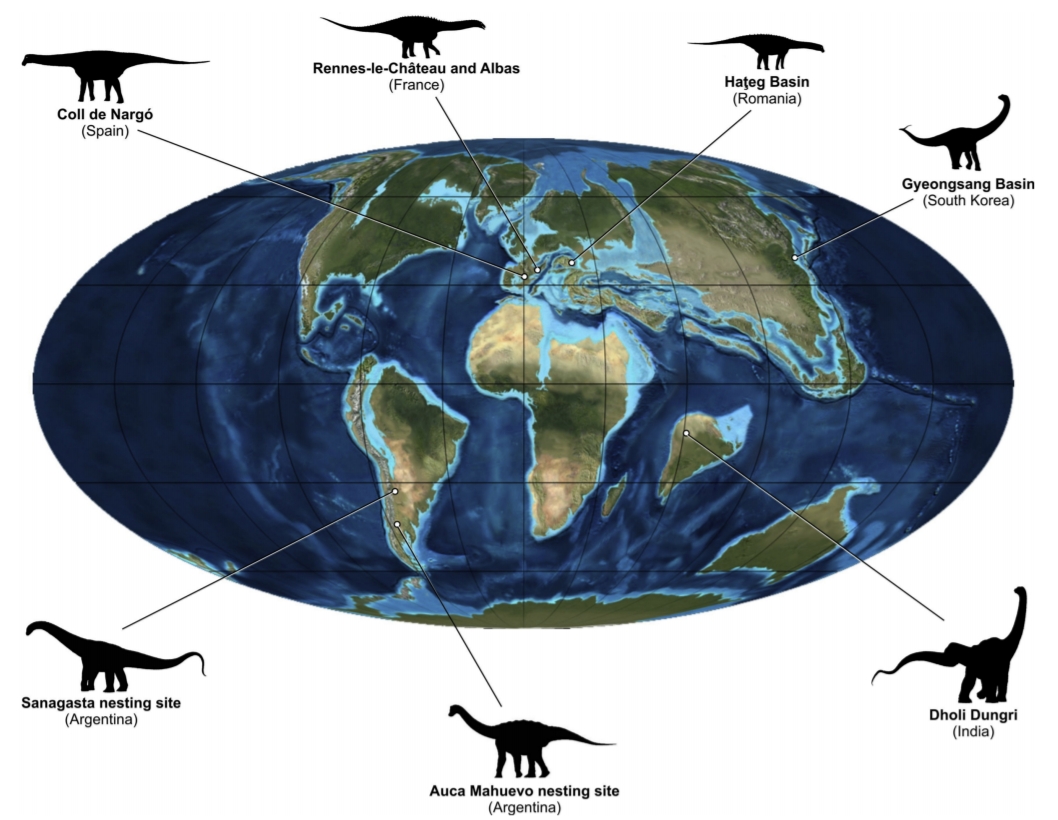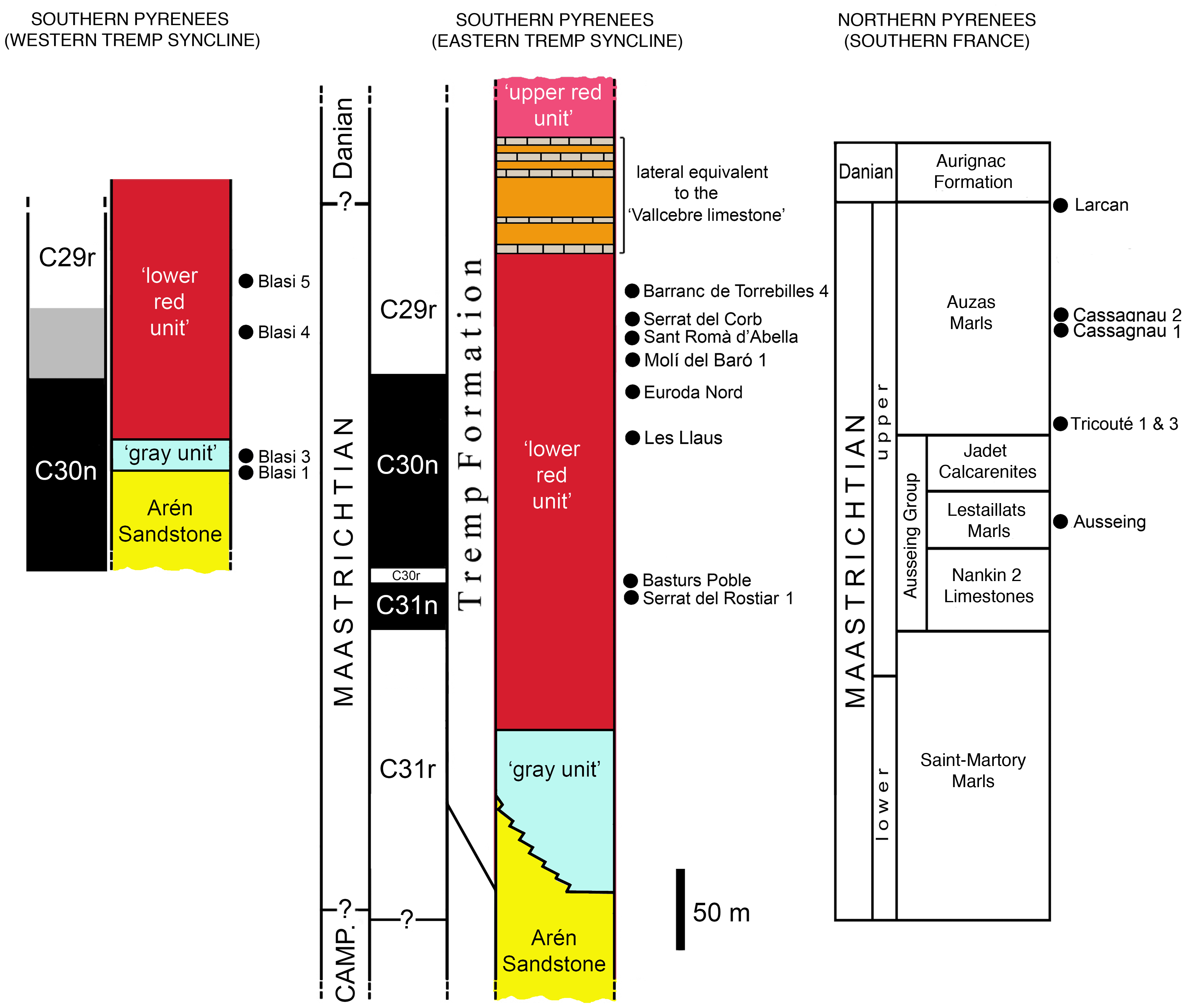|
Arén Formation
The Arén Formation or Arén Sandstone (Catalan: Calcàries i gresos d’Areny)Arengol Segú, 2014, p.31 is a geological formation in the Tremp-Graus Basin around Arén, Catalonia, Spain whose strata date back to the Late Cretaceous.Arén Formation at .org Dinosaur remains are among the fossils that have been recovered from the formation.Weishampel et al., 2004, pp.588-593 The formation dates to the to |
Geological Formation
A geological formation, or simply formation, is a body of rock having a consistent set of physical characteristics ( lithology) that distinguishes it from adjacent bodies of rock, and which occupies a particular position in the layers of rock exposed in a geographical region (the stratigraphic column). It is the fundamental unit of lithostratigraphy, the study of strata or rock layers. A formation must be large enough that it can be mapped at the surface or traced in the subsurface. Formations are otherwise not defined by the thickness of their rock strata, which can vary widely. They are usually, but not universally, tabular in form. They may consist of a single lithology (rock type), or of alternating beds of two or more lithologies, or even a heterogeneous mixture of lithologies, so long as this distinguishes them from adjacent bodies of rock. The concept of a geologic formation goes back to the beginnings of modern scientific geology. The term was used by Abraham Gottlob Wer ... [...More Info...] [...Related Items...] OR: [Wikipedia] [Google] [Baidu] |
Dinosaur
Dinosaurs are a diverse group of reptiles of the clade Dinosauria. They first appeared during the Triassic period, between 243 and 233.23 million years ago (mya), although the exact origin and timing of the evolution of dinosaurs is the subject of active research. They became the dominant terrestrial vertebrates after the Triassic–Jurassic extinction event 201.3 mya; their dominance continued throughout the Jurassic and Cretaceous periods. The fossil record shows that birds are feathered dinosaurs, having evolved from earlier theropods during the Late Jurassic epoch, and are the only dinosaur lineage known to have survived the Cretaceous–Paleogene extinction event approximately 66 mya. Dinosaurs can therefore be divided into avian dinosaurs—birds—and the extinct non-avian dinosaurs, which are all dinosaurs other than birds. Dinosaurs are varied from taxonomic, morphological and ecological standpoints. Birds, at over 10,700 living species, are among ... [...More Info...] [...Related Items...] OR: [Wikipedia] [Google] [Baidu] |
Halszka Osmólska
Halszka Osmólska (September 15, 1930 – March 31, 2008) was a Polish paleontologist who had specialized in Mongolian dinosaurs. Biography She was born in 1930 in Poznań. In 1949, she began to study biology at Faculty of Biology and Earth Sciences of the University of Poznań before moving to Warsaw and studying at the Warsaw University, which she graduated from in 1955. Since then she worked at the Institute of Paleobiology of the Polish Academy of Sciences (PAN). Between 1983–1988, she served as the institute's director. She was a member of the Polish–Mongolian expeditions to the Gobi Desert (1963–1965 and 1967–1971) and she described many finds from these rocks, often with Teresa Maryańska. Among the dinosaurs she described are: * ''Elmisaurus'' (and Elmisauridae) (1981), ''Hulsanpes'' (1982), '' Borogovia'' (1987), and ''Bagaraatan'' (1996) * with Maryańska, ''Homalocephale'', ''Prenocephale'', and ''Tylocephale'' (and Pachycephalosauria)(1974), ''Bagaceratops'' ... [...More Info...] [...Related Items...] OR: [Wikipedia] [Google] [Baidu] |
Peter Dodson
Peter Dodson (born August 20, 1946) is an American paleontologist who has published many papers and written and collaborated on books about dinosaurs. An authority on Ceratopsians, he has also authored several papers and textbooks on hadrosaurs and sauropods, and is a co-editor of ''The Dinosauria'', widely considered the definitive scholarly reference on dinosaurs. Dodson described ''Avaceratops'' in 1986; ''Suuwassea'' in 2004, and many others, while his students have named ''Paralititan'' and '' Auroraceratops''. He has conducted field research in Canada, the United States, India, Madagascar, Egypt, Argentina, and China. A professor of vertebrate paleontology and of veterinary anatomy at the University of Pennsylvania, Dodson has also taught courses in geology, history, history and sociology of science, and religious studies. Dodson is also a research associate at the Academy of Natural Sciences. In 2001, two former students named an ancient frog species, '' Nezpercius dodsoni' ... [...More Info...] [...Related Items...] OR: [Wikipedia] [Google] [Baidu] |
David B
David Robert Jones (8 January 194710 January 2016), known professionally as David Bowie ( ), was an English singer-songwriter and actor. A leading figure in the music industry, he is regarded as one of the most influential musicians of the 20th century. Bowie was acclaimed by critics and musicians, particularly for his innovative work during the 1970s. His career was marked by reinvention and visual presentation, and his music and stagecraft had a significant impact on popular music. Bowie developed an interest in music from an early age. He studied art, music and design before embarking on a professional career as a musician in 1963. "Space Oddity", released in 1969, was his first top-five entry on the UK Singles Chart. After a period of experimentation, he re-emerged in 1972 during the glam rock era with his flamboyant and androgynous alter ego Ziggy Stardust (character), Ziggy Stardust. The character was spearheaded by the success of Bowie's single "Starman (song), Starma ... [...More Info...] [...Related Items...] OR: [Wikipedia] [Google] [Baidu] |
Palaeontology (journal)
''Palaeontology'' is one of the two scientific journals of the Palaeontological Association (the other being '' Papers in Palaeontology''). It was established in 1957 and is published on behalf of the Association by Wiley-Blackwell. The editor-in-chief is Barry Lomax (University of Nottingham). ''Palaeontology'' publishes articles on a range of palaeontological topics, including taphonomy, functional morphology, systematics, palaeo-environmental reconstruction and biostratigraphy. According to the ''Journal Citation Reports'', the journal has a 2017 impact factor The impact factor (IF) or journal impact factor (JIF) of an academic journal is a scientometric index calculated by Clarivate that reflects the yearly mean number of citations of articles published in the last two years in a given journal, as i ... of 3.730, ranking it 1st out of 55 journals in the category "Paleontology". References External links * Paleontology journals Publications established in 1957 ... [...More Info...] [...Related Items...] OR: [Wikipedia] [Google] [Baidu] |
List Of Dinosaur-bearing Rock Formations
This list of dinosaur-bearing rock formations is a list of geologic formations in which dinosaur fossils have been documented. Containing body fossils * List of stratigraphic units with dinosaur body fossils ** List of stratigraphic units with few dinosaur genera ** List of stratigraphic units with indeterminate dinosaur fossils Containing trace fossils * List of stratigraphic units with dinosaur trace fossils ** List of stratigraphic units with dinosaur tracks *** List of stratigraphic units with ornithischian tracks *** List of stratigraphic units with sauropodomorph tracks *** List of stratigraphic units with theropod tracks See also * Lists of fossiliferous stratigraphic units * List of fossil sites * Mesozoic The Mesozoic Era ( ), also called the Age of Reptiles, the Age of Conifers, and colloquially as the Age of the Dinosaurs is the second-to-last era of Earth's geological history, lasting from about , comprising the Triassic, Jurassic and Cretaceo ... {{DEFAULTSOR ... [...More Info...] [...Related Items...] OR: [Wikipedia] [Google] [Baidu] |
Titanosaurus
''Titanosaurus'' (; ) is a dubious genus of sauropod dinosaurs, first described by Richard Lydekker in 1877.R. Lydekker. (1877). Notices of new and other Vertebrata from Indian Tertiary and Secondary rocks. ''Records of the Geological Survey of India'' 10(1):30-43 It is known from the Maastrichtian (Upper Cretaceous) Lameta Formation of India. Discovery and naming ''Titanosaurus'', literally meaning 'titanic lizard', was named after the mythological Titans. ''Titanosaurus'' was the first Indian dinosaur to be named and properly described, having been recorded for the first time in 1877. The type species, ''T. indicus'', was named in 1877, and the second species, ''T. blanfordi'', was named in 1879.R. Lydekker. (1879). Fossil Reptilia and Batrachia. ''Memoirs of the Geological Survey of India. Palaeontologia Indica, Series IV. Indian Pretertiary Vertebrata'' 1(3):1-36 Both species were named by Richard Lydekker. ''T. indicus'' and ''T. blanfordi'' are 70 million years old. ''Ti ... [...More Info...] [...Related Items...] OR: [Wikipedia] [Google] [Baidu] |
Rhabdodon By Tom Parker
''Rhabdodon'' (meaning "fluted tooth") is a genus of ornithopod dinosaur that lived in Europe approximately 70-66 million years ago in the Late Cretaceous. It is similar in build to a very robust "hypsilophodont" (non-iguanodont ornithopod), though all modern phylogenetic analyses find this to be an unnatural grouping, and ''Rhabdodon'' to be a basal member of Iguanodontia. It was large amongst its relatives, measuring long and weighing , with some specimens possibly reaching up to long. Discovery Two species of ''Rhabdodon'' are known, ''Rhabdodon priscus'', the type species, and ''R. septimanicus'' (Buffetaut and Le Loeuff, 1991). ''Rhabdodon'' remains are currently known from southern France, although fragmentary remains from eastern Spain have been assigned to the genus. ''Rhabdodon'' was large compared to its nearest relatives, and indeed one recent paper ( Ősi ''et al.'' (2012)) determined it is larger than the basal rhabdodontid status; from this they suggested that it ... [...More Info...] [...Related Items...] OR: [Wikipedia] [Google] [Baidu] |
Rhabdodon
''Rhabdodon'' (meaning "fluted tooth") is a genus of ornithopod dinosaur that lived in Europe approximately 70-66 million years ago in the Late Cretaceous. It is similar in build to a very robust "hypsilophodont" (non-iguanodont ornithopod), though all modern phylogenetic analyses find this to be an unnatural grouping, and ''Rhabdodon'' to be a basal member of Iguanodontia. It was large amongst its relatives, measuring long and weighing , with some specimens possibly reaching up to long. Discovery Two species of ''Rhabdodon'' are known, ''Rhabdodon priscus'', the type species, and ''R. septimanicus'' (Buffetaut and Le Loeuff, 1991). ''Rhabdodon'' remains are currently known from southern France, although fragmentary remains from eastern Spain have been assigned to the genus. ''Rhabdodon'' was large compared to its nearest relatives, and indeed one recent paper ( Ősi ''et al.'' (2012)) determined it is larger than the basal rhabdodontid status; from this they suggested that it ... [...More Info...] [...Related Items...] OR: [Wikipedia] [Google] [Baidu] |
Pararhabdodon
''Pararhabdodon'' (meaning "near fluted tooth" in reference to ''Rhabdodon'') is a genus of tsintaosaurin hadrosaurid dinosaur, from the Maastrichtian-age Upper Cretaceous Tremp Group of Spain. The first remains were discovered from the Sant Romà d’Abella fossil locality and assigned to the genus ''Rhabdodon'', and later named as the distinct species ''Pararhabdodon isonensis'' in 1993. Known material includes assorted postcranial remains, mostly vertebrae, as well as from the skull. Specimens from other sites, including remains from France, a maxilla previously considered the distinct taxon ''Koutalisaurus kohlerorum'', an additional maxilla from another locality, the material assigned to the genera ''Blasisaurus'' and ''Arenysaurus'', and the extensive Basturs Poble bonebed have been considered at different times to belong to the species, but all of these assignments have more recently been questioned. It was one of the last non-avian dinosaurs known from the fossil record th ... [...More Info...] [...Related Items...] OR: [Wikipedia] [Google] [Baidu] |



.png)




